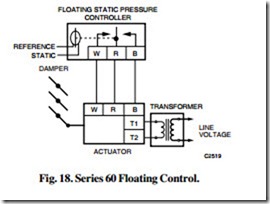SERIES 60 FLOATING CONTROL CIRCUITS
APPLICATION
A Series 60 floating control circuit is a line- or low-voltage control circuit comprising a spdt controller with a center-off (floating) position and a reversible actuator. On a change in the controlled variable, the controller drives the actuator to an intermediate position and then opens the circuit to the actuator. The actuator remains in this position until a further change at the controller. The actuator is said to float between the limits of the controller to satisfy various load requirements. In many systems, Series 60 floating control provides adequate modulating control.
To provide stable Series 60 floating control, careful consideration must be given to the speed of response of the controller and the timing of the actuator. For a given change in the system, the actuator timing and the subsequent change in the controlled variable must be slower than the response time of the controller. To accomplish this, Series 60 actuators are available with various drive speeds.
Series 60 floating control circuits can be used for:
1. Control of two-way or three-way valves.
2. Control of dampers.
3. Control of inlet vane or other static pressure regulating equipment.
The basic Series 60 floating control circuit consists of a Series 60 actuator and a Series 60 floating controller. Various limit controllers can be added where required.
EQUIPMENT
CONTROLLERS
1. Floating temperature controllers.
2. Floating pressure controllers.
3. Simulated Series 60 floating control using two Series 40 or 80 controllers.
Series 60 floating controllers are three-wire, line- or low-voltage devices with a spdt switching action and a center off position.
ACTUATORS
The actuators discussed in SERIES 60 TWO-POSITION CONTROL are also used for floating control. In addition, actuator assemblies are available with two, single direction motors driving a common shaft. One motor drives the shaft in one direction, and the other motor drives the shaft in the other direction.
OPERATION
Operation of the Series 60 floating control circuit is similar to that discussed in SERIES 60 TWO-POSITION CONTROL with one major difference: the controller has a center off position allowing the actuator to stop at positions between the open limit and the close limit.
CONTROL COMBINATIONS
Series 60 floating control can be used to regulate static or differential pressures in applications where the pressure pickup can sense changes and position a damper actuator at intermediate locations between open and closed. Figure 18 illustrates a static pressure controller connected to a Series 60 damper actuator. A drop in static pressure to the controller setpoint closes R to B at the controller and causes the actuator to drive toward open. As soon as the static pressure increases above the setpoint, R to B opens and the actuator stops. The moveable contact R of the controller remains at the center or neutral position until a further drop causes the actuator to open the damper further. On a rise in static pressure to the setpoint plus a differential, or dead band, R to W closes driving the actuator toward closed. When the controller is satisfied, R to W opens stopping the actuator. Thus, the damper actuator floats between open and closed limits to maintain static pressure.
